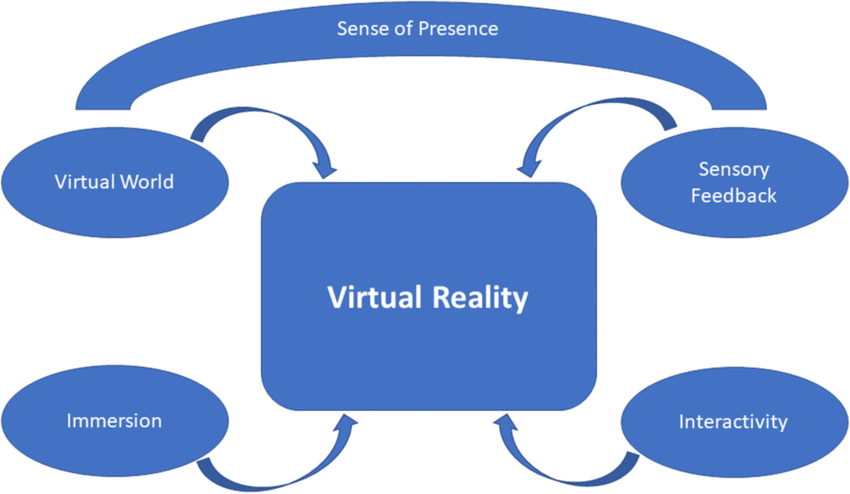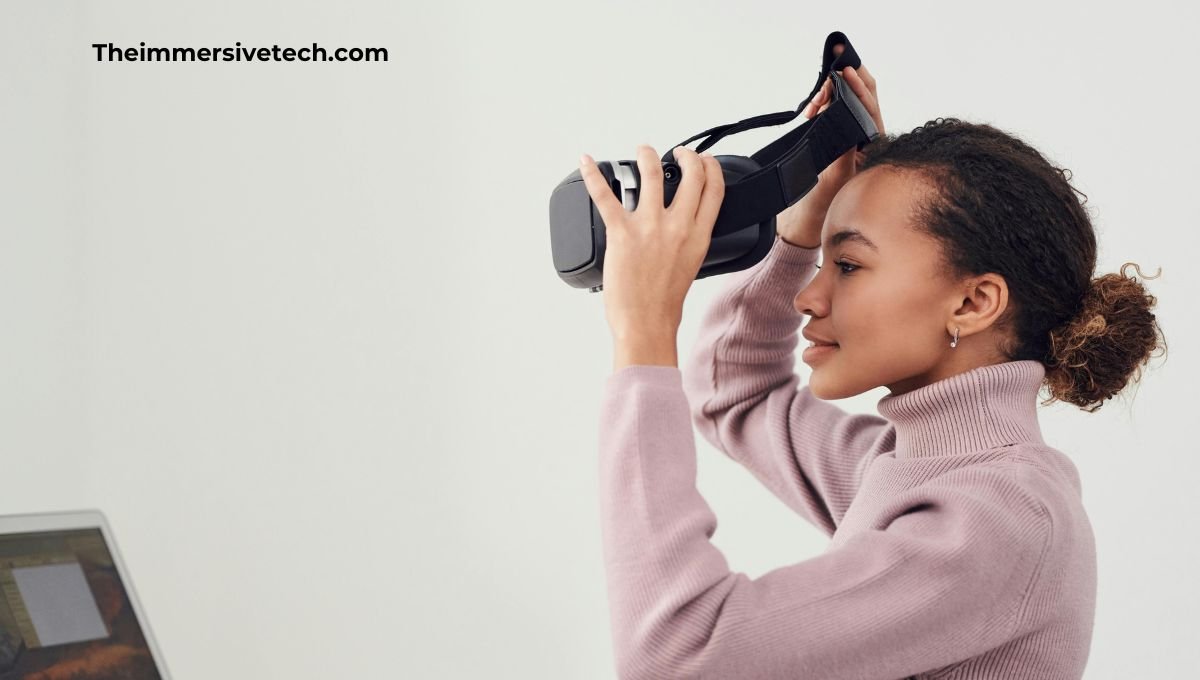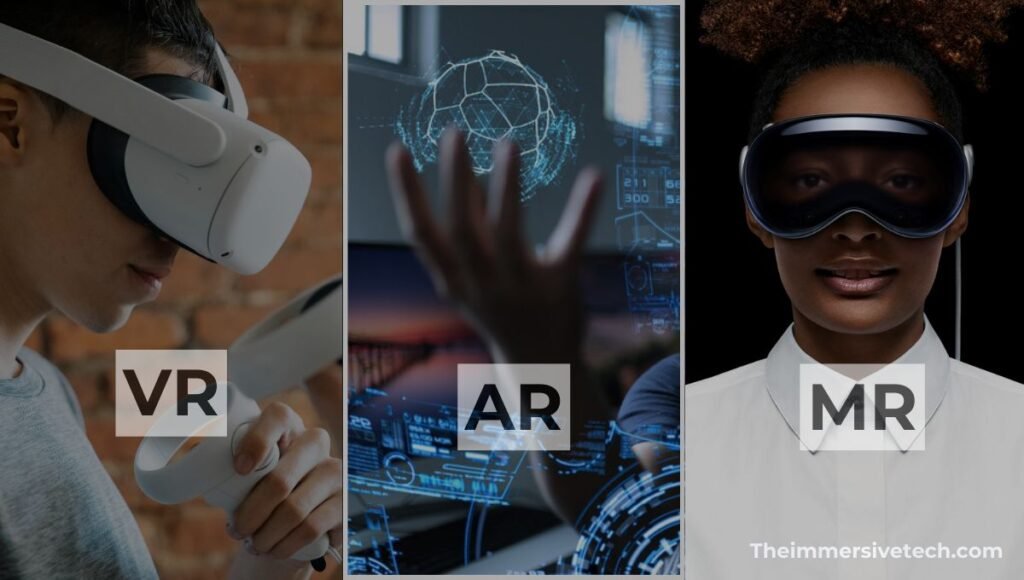Virtual reality (VR) has taken off a lot since 2019. However, it has been even crazier after the launch of Apple Vision Pro in 2023. Companies are innovating and inventing new technologies everyday to extend the involvement of VR to the common people for day-to-day purposes such as entertainment, interacting, conferencing, games, etc.
People can virtually go anywhere they want and carry out lots of business activities in a VR environment rather than just a computer screen, from the comfort of their home. However, virtual reality has some cons as well. It’s equally important to understand the long term impact of virtual reality on the body and mind.
So, let’s dive into this introduction to virtual reality and look at the wonders virtual reality has brought into the world.
Virtual Reality
1. Definition of Virtual Reality
Virtual reality (VR) is a computer-generated environment that is very similar to the real world. The whole environment is created with computer hardware and software. Wearing a VR headset or goggles, users can interact with their virtual surroundings as if it’s real.
These VR devices provide a 3D experience to the users, making them feel immersed in the virtual world. Although there are a lot of applications of VR, most people use it for entertainment, educational, and business purposes.
2. Brief History of VR
The history of VR dates back to the 1950s when the first VR machine was invented. If developed further, it could’ve fully immersed people in the virtual world, as we know it now.
The most initial virtual reality creations were either uncomfortable or underdeveloped for the users. Thus, none of them ever really came to use. In the late 1970s, VR became more developed, with features such as eye-movement tracking.
In 1991, the first-ever 3D VR gaming system was introduced. It featured VR headsets and real-time immersive stereoscopic 3D images.
3. Evolution of VR Technology
The first VR consoles weren’t comfortable, and lacked coloured graphics and software support. Since 1995, a lot of VR systems have been developed and released. The 2010s was a major decade for the evolution of VR technology.
From VR headsets with buttons to sensor-tracking VR headsets, the world has seen a lot. In fact, 2019 was predicted to be ‘The Year Virtual Reality Gets Real’ by Forbes.
Types of Virtual Reality (VR)
Depending on the type of VR a user uses, they can control how much they immerse into the virtual reality. For instance, anything from a simple video game to a whole virtual environment counts as VR.
On a similar basis, there are three types of VR:
1. Fully-immersive
This type of VR completely immerses the user in a simulated 3D world, providing the greatest experience. The users can see, hear, and even touch and smell in some cases.

To interact in such an environment, the users wear special VR equipment such as helmets, goggles, or gloves. Fully-immersive virtual reality is helpful in the healthcare sector, along with its use in gaming.
2. Semi-immersive
Semi-immersive virtual reality offers a partially-immersive experience to the users through a computer screen, special glasses, or headset. It offers only the 3D visual aspect of virtual reality, and doesn’t incorporate any physical movement like in fully-immersive VR. One example of semi-immersive VR is the flight simulator used by airlines and militaries.

3. Non-immersive
Non-immersive, also known as screen-based VR, doesn’t immerse the user in virtual reality at all. Instead, users can access a 3D simulated environment through a computer screen. Video games are a great example of non-immersive VR. So, users also have some control over the virtual environment using a mouse and keyboard.

Evolution of VR Technology

1995 - 2001
The first Virtual Boy console by Nintendo was released in 1995, which played 3D monochrome video games. It was also the first portable console to display 3D graphics. However, it was a commercial failure due to lack of quality graphics and software.
In 1997, VR was used to create war zone scenarios for veterans receiving exposure therapy for PTSD. This later came to be known as ‘Virtual Vietnam’.
Then in 2001, the first PC based cubic room, “SAS Cube” was introduced, which led to Virtools VR Pack.
2007 - 2014
This was the time when big companies started coming up with VR.
Google introduced Street View in 2007. In 2010, Google added another feature called “stereoscopic 3D mode” to its Street View.
Within the same year, an 18-year-old entrepreneur, Palmer Luckey, created the first prototype of the Oculus Rift headset. It featured a 90-degree field of vision, which was never seen before. This also led to a spark in VR.
Luckey launched a Kickstarter campaign for Oculus Rift in 2012, raising $2.4 million. However, the Oculus VR company was bought by Facebook for $2 billion only after two years.
2014 was also the time when different companies started launching their first-ever VR headsets. The list included Google’s Cardboard, Samsung Gear VR, and Sony’s soon-to-be-launched PS4.
2015 - 2018
The VR possibilities started becoming real to the general public in 2015, with an array of events happening. For instance, BBC created a 360-degree video of a Syrian migrant camp.
By 2016, hundreds of companies were developing VR systems. Most of the headsets came up with dynamic binaural audio. The same year, the HTC VIVE SteamVR headset was released with sensor-based tracking for the first time ever.
At Facebook F8, Oculus showed a new headset prototype called “the Half Dome” in 2018. This varifocal headset had a 140-degree field of vision. By this time, VR started to have a lot of applications.
2019 - Present
2019 was the year when virtual reality got real. There was a shift from tethered to standalone VR headsets in an immersive ecosystem. Facebook’s Oculus Quest sold out in various locations, generating $5 million worth of sales.
In 2020, Oculus Quest 2 was released which again, sold out around the globe. However, its competitor, the Pico Neo 3 headset was released soon after.
Finally in 2023, Apple entered the VR market with its first VR headset, the Apple Vision Pro. It was priced at $3,500. Meanwhile, Meta announced its Meta Quest 3 which was priced at $499.
Working of Virtual Reality Technology
1. Core Components of VR Systems
Some of the core components of VR systems include headset, input devices, output devices, software, motion controllers, tracking system, and avatar embodiment. All these components make up a VR system, allowing an immersive virtual reality experience.

Source: Research Gate
2. Immersive Environments in VR
Immersion is the core of virtual reality. Depending on the type of VR system you are using, the immersion level varies. For instance, a computer system is non-immersive. On the other hand, VR headsets are supposed to fully immerse the user in the virtual environment.
Fully-immersive, VR environments are created using 3D modelling software to design realistic objects and scenes. VR environments can also be created using VR photography.
VR photography involves stitching a number of photos taken from an omnidirectional camera.The whole virtual reality image could also be computer generated, or a photograph with a few virtual elements. Additionally, virtual environments can also be created using 360-degree videos.
Future of VR Technology
VR has changed the way people interact with each other. For instance, anyone with a smartphone can see their friends from a mile away on a video call. It’s non-immersive VR. On the other hand, people can see and feel the other person in fully-immersive VR. Thus, virtual reality will definitely change the way people interact with each other.
While there are many advantages of VR, it could also have a negative impact on society. Virtual reality is addictive, which raises concerns on the health of the users, including children. VR will impact people’s privacy as well.
Top Industry Using VR Technology
Virtual Reality has a role in segments other than games. In this introduction to virtual reality guide, we will see some of the real-life applications of VR:
1. Gaming and Entertainment

Source: 4experience.co
Virtual reality has been popular for gaming since the early 2010s. With the launch of next-generation commercial headsets such as Oculus (Rift), HTC (Vive), and Sony (PlayStation VR), the world saw a new form of gaming.
On the other hand, VR has also led to the 3D Cinema that people use to watch sporting events, concerts, movies, and pornography. The joy of roller coasters and theme parks is also possible at home now!
2. Education and Training
Students can converse together in a 3D setup. In addition, virtual classrooms have also been introduced after the COVID-19 pandemic. Education becomes more fun as VR can be used to create 3D virtual environments to explain concepts.

Source: eLearning Industry
Virtual reality can also be used to create simulated training environments for trainees. Using VR, trainees get to enter a 360 degree, active learning environment and learn effectively.
3. Healthcare
VR has been used as an exposure therapy to treat anxiety disorders such as post traumatic stress disorder (PTSD) and phobias. A VR therapy has also been designed to treat people with psychosis and agoraphobia to help them manage their avoidance of outside environments.
During the COVID-19 pandemic, virtual reality has also been used as a mental-health tool for non-traditional cognitive behavioural therapy. Additionally, 17 studies in recent times have shown that virtual reality applications are effective in the treatment of cognitive deficits with neurological diagnoses.
Experts also say that virtual reality can provide effective and repeatable training at a relatively low cost, along with the trainees being able to recognize and amend errors quickly.
4. Automotive Industries
Smart cars rely on AI and VR to learn how to drive, turn, and stop. In fact, virtual reality is widely used in the development of smart cars. For instance, VR assists the manufacturers in analysing road scenarios and the behaviour of the cars. Such simulated situations help them analyse and make changes to the prototypes before designing any new model.
Choosing the Right VR Headset
1. Consumer VR Options
As a consumer, you can choose any of the popular VR systems that match your requirements. Here are some of the VR systems that you might like:
- Meta Quest 3
- HP Reverb G2
- Meta Quest 2
- Samsung Gear VR
Here, VR systems such as Meta Quest 2 and HP Reverb G2 are affordable and comfortable. Thus, these are the recommended VR system options for consumers.
2. Business and Enterprise VR Solutions
VR systems can be the ultimate productivity tool for businesses and enterprises. It can be used for team meetings, project collaborations, workshops, and more. Additionally, virtual reality can be a potential advertising tool due to high engagement rates.
Some of the VR systems for enterprises include HTC Vive Pro, Oculus, and Varjo. Companies can also seek custom VR solutions as per their requirements.
Impact of Virtual Reality on Industries
Virtual reality isn’t limited to only one industry. It has its impact on a lot of industries, from education to architecture. Here is the impact of VR on various industries:
1. Business and Marketing
Virtual reality can have a great impact on marketing and business. For instance, VR can be used to create marketing campaigns, collaborate with other businesses, and generate leads.
VR can also be used to create an engaging environment for employees to boost their productivity. In marketing, the 360-degree videos are helpful to create compelling, storytelling videos.
2. Architecture and Design
In architecture and design, virtual reality can be used to simulate various design scenarios and evaluate the energy efficiency of building components, systems, and materials. Hence, helping the architects and engineers choose the most efficient options.
Tips for a Great VR Devices
The best VR experience is when you are comfortable, physically well, and have full control of your VR system. Here are several tips to improve your VR experience:
1. Enough Space in the Room
Although you don’t need to have a room dedicated to enjoy VR, there must be enough space for you to move around without getting injured. So, you can place a carpet in the middle of the room and keep all the obstacles aside.
2. Adjust Your Headset
Each VR headset has its own way to adjust to the user’s comfort. For example, the Meta Quest 2 Headset has three lenses that can be switched for a better image clarity. In addition, the headset also allows users to wear their glasses while wearing the VR headset
3. Stay Hydrated
VR systems can cause motion sickness on extended use. So, you must drink enough water to prevent motion sickness. Turn on the fan to allow ventilation. For additional safety, have enough space around yourself to avoid any bumps.
4. Have a Controller Grip
If you get your hands very sweaty, use products that keep your hands dry to have a better controller grip. For instance, gym chalk is an option to keep your hands dry.
Challenges and Limitations of Virtual Reality
Virtual reality has several limitations as well. Here, we have listed some:
1. Discomfort
Prolonged use of VR can lead to discomfort or motion sickness for some users. In addition, the heavy weight of VR headsets could cause cervical issues and thus, they aren’t suitable for extended periods of time.
2. Ethical Considerations
Since VR is also a part of the advanced technology, it comes with considerable privacy concerns. For instance, most of the VR headsets have eye tracking sensors as a standard feature.
These eye tracking sensors can reveal a user’s information such as their ethnicity, personality traits, emotions, skills, and physical & mental conditions. In addition, advanced VR systems may also collect the user’s biometric data. All of this data leads to significant privacy concerns.
VR systems extend the risk of data breach with the potential exposure of biometric data. In fact, there is a possibility of virtual identity theft where malicious users could steal the avatars and personas of users and misuse them.
3. Psychological Impact
Most VR headsets come with a consumer warning stating the psychological impact the system may have on the user. Prolonged use of fully-immersive VR could lead to seizures, developmental issues in children, trip-and-fall and collision warnings, and repetitive stress injury.
Some people may experience eye fatigue as well. Although not everybody experiences these, VR systems aren’t advised for children.
Frequently Asked Questions (FAQs)
Q1. What is the difference between VR and AR?
The main difference between augmented reality (AR) and virtual reality (VR) is that VR replaces the real world with a virtual one, while AR adds digital elements to the real world. Since AR doesn’t change the real world, people don’t immerse themselves into the virtual elements completely.
Q2. Are there any age restrictions for using VR?
Yes, most VR manufacturers don’t advise children under the age of 13 to use VR systems. It’s because young children have a greater risk of physical and psychological impacts of using VR systems than adults.
Q3. Are there affordable options for experiencing VR at home?
Yes, some of the affordable VR options include Google Cardboard, Oculus Quest 2, and Mobile VR applications. Other affordable VR headsets include the Meta Quest 2, PlayStation VR2, and Atlasonic VR Headset.
Q4. How secure is the data collected during VR experiences?
VR headsets can collect biometric data such as facial images, fingerprints, iris and retina scans, and voiceprints. Therefore, making it easy for anyone to identify the user with high accuracy. So, the data isn’t quite secure and the risks of data theft and cyber attacks are high in VR.
Conclusion
In the past decade, VR has evolved a lot — from button-based controllers to sensor trackers. From the first prototype of Oculus Rift to the Apple Vision Pro, there have been many upgrades in the VR technology.
With virtual reality, the world will be immersed in the virtual world in the future. Looking at people working while wearing a VR headset, it seems like the future holds a lot for this advanced technology.
I hope this guide on introduction to virtual reality was helpful.
Comment below with your thoughts.







